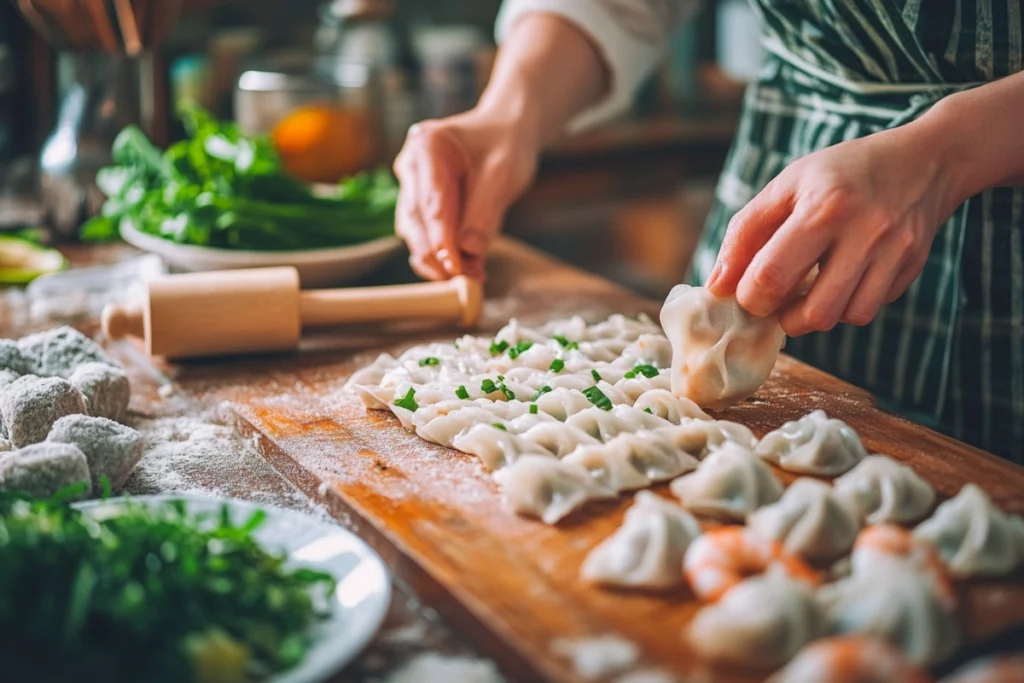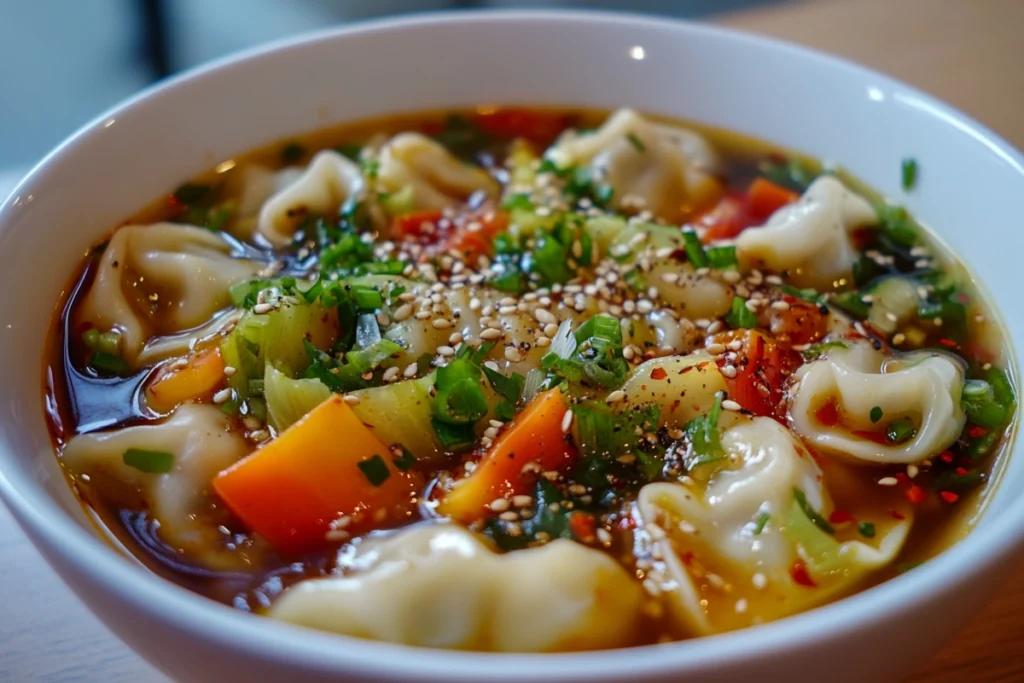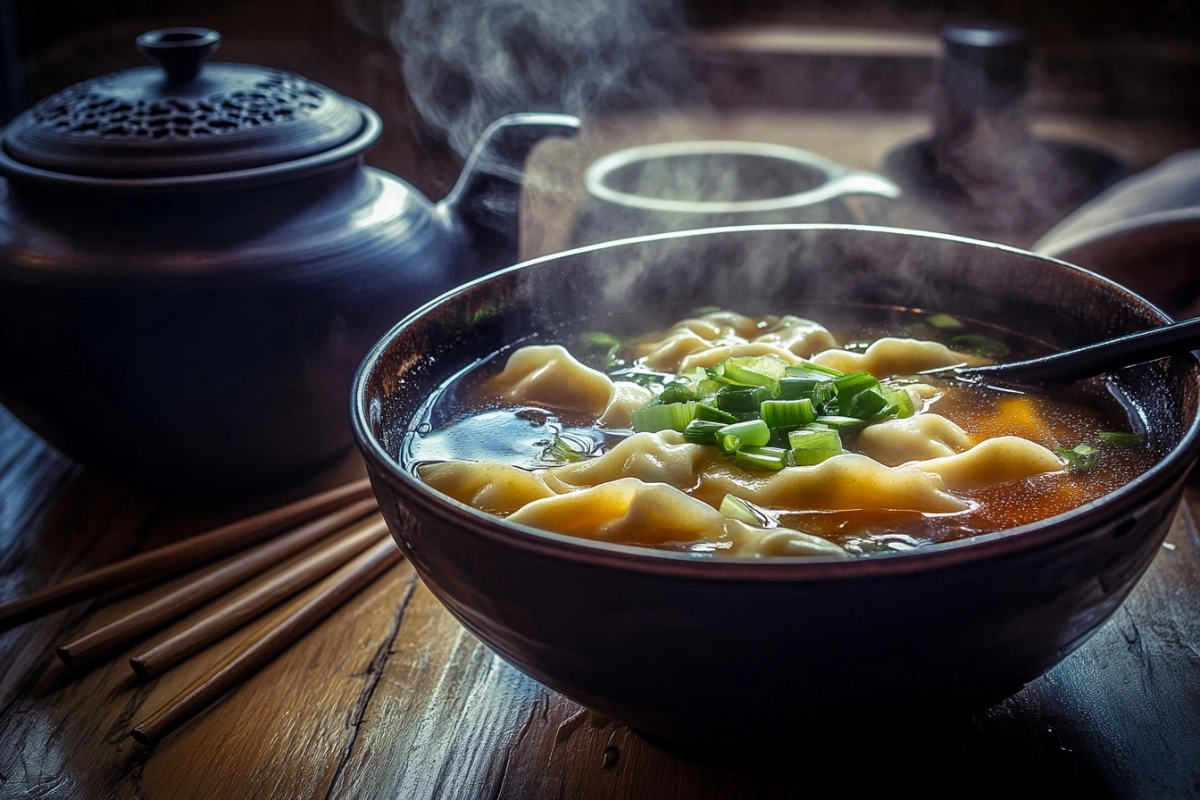Wonton soup transcends its status as a popular dish in China; it serves as a cultural symbol and a warm, comforting tradition. For centuries, this simple yet flavorful delicacy has played a significant role in Chinese culinary heritage, reflecting the essence of the country’s food culture. Its journey from historical roots to modern adaptations intertwines closely with family gatherings, festivals, and daily meals. This article delves into how Chinese eat wonton soup, exploring the rich traditions behind it and the unique ways people prepare and enjoy this beloved dish.
Let’s dive into the cultural significance of this beloved dish.
The Cultural Significance of Wonton Soup in China
Historical Roots of Wonton Soup
Wonton soup traces its origins back to ancient China, with references dating as far back as the Han Dynasty (206 BCE–220 CE). The word “wonton” itself is derived from the Cantonese pronunciation wàhn tān, meaning “swallowing clouds.” This poetic name describes how the delicate dumplings float in the soup like fluffy clouds. Historically, wontons were considered a luxury, enjoyed by the wealthy due to the labor-intensive process of making them by hand.
Over time, the dish became accessible to all social classes, evolving into a staple of Chinese street food and home-cooked meals. Wonton soup was traditionally consumed during special occasions, including the Winter Solstice, as a symbol of warmth and family togetherness. Its cultural roots highlight the importance of food as a medium for connecting generations.
Wonton Soup’s Role in Festivals and Celebrations
Wonton soup plays a starring role in many Chinese festivities. During the Lunar New Year, wontons symbolize prosperity and happiness due to their resemblance to gold ingots, the ancient Chinese currency. Eating wonton soup during these celebrations is believed to bring good luck and wealth for the year ahead.
Similarly, in southern China, wontons are often enjoyed during the Dragon Boat Festival and other local festivities. Families gather to wrap wontons together, turning the act of cooking into a cherished bonding experience. For many, the soup represents comfort, family unity, and a sense of belonging.
In modern China, wonton soup has transcended its festive roots to become an everyday comfort food. Whether served at home, in bustling street markets, or high-end restaurants, its presence reflects a blend of tradition and adaptability.
Traditional Ways of Preparing Wonton Soup in China
Regional Variations of Wonton Soup
In China, wonton soup is a versatile dish with distinct regional adaptations. In Cantonese cuisine, the soup is clear and lightly seasoned to let the flavors of shrimp wontons shine. On the other hand, Sichuan wontons, known as “Chao Shou,” are often served in a spicy chili oil broth, catering to the region’s love for bold flavors.
Northern Chinese wontons tend to be heartier, featuring thicker wrappers and a variety of fillings such as lamb, leeks, or cabbage. Meanwhile, in Shanghai, wontons are smaller and served in a simple broth or paired with sesame oil and soy sauce for extra depth. These regional twists show how Chinese people adapt how they eat wonton soup to match their local ingredients and culinary traditions.
Key Ingredients Used in Authentic Recipes
A traditional wonton starts with a delicate wrapper, typically made from wheat flour and water, rolled paper-thin for that signature “swallowing clouds” effect. Fillings vary by region, shrimp, ginger, scallions, and sesame oil are common staples. The broth is equally crucial, with many recipes calling for a base of chicken simmered for hours to achieve a rich, clear stock.
In coastal areas, seafood-based broths are popular, while inland recipes may include dried mushrooms, giving the soup an earthy note. Additional condiments like white pepper, soy sauce, and chili oil can be added at the table, letting diners customize their bowls to taste. These ingredients exemplify how Chinese cuisine emphasizes balance and harmony in flavor profiles.
For further exploration of broth-based comfort foods, check out Subgum Wonton Soup to learn about another flavorful variation.
How Wonton Soup Is Served and Eaten in Chinese Culture
Typical Serving Methods and Etiquette
Traditionally, people serve wonton soup in small bowls, often enjoying it as a starter or light meal. They ladle the wontons into the bowl first and then pour the steaming broth over them, ensuring that each dumpling stays intact. Finally, they sprinkle garnishes like chopped scallions, coriander, or crispy garlic on top, creating an aromatic and visually appealing finish.
When dining, Chinese etiquette places importance on savoring the broth before diving into the wontons. This practice highlights respect for the chef’s craftsmanship in creating a flavorful soup base. Sharing is also customary; family-style dining often involves passing bowls of wonton soup around, reflecting the communal spirit of Chinese meals.
Enhancements with Condiments and Sides
Though delicious on its own, wonton soup is often paired with side dishes to create a balanced meal. In southern China, crispy fried spring rolls or steamed buns complement the lightness of the soup. In contrast, northern regions may serve it alongside hearty scallion pancakes or pickled vegetables for a tangy kick.
Condiments play a pivotal role in enhancing the dish. Soy sauce, black vinegar, and chili oil are commonly offered, allowing diners to customize their wontons. This personalization underscores how Chinese eat wonton soup—not just as a dish, but as a dynamic, interactive experience.
Nutritional and Health Aspects of Wonton Soup
Common Nutritional Benefits
Wonton soup is not just a comfort food; it also offers a range of health benefits. A typical serving is low in calories, especially when prepared with a clear broth. The wontons, usually made with shrimp, provide a healthy dose of protein, while the ginger and scallions in the filling are known for their anti-inflammatory properties.
The soup’s broth often contains minerals like calcium and magnesium from bones simmered over hours. When paired with fresh vegetables or herbs, wonton soup becomes a balanced dish that is both satisfying and nourishing.
Adaptations for Health-Conscious Diets
For those who prefer a lighter option, wonton soup can be modified easily. Using whole-wheat wonton wrappers boosts fiber content, and switching to a vegetable broth makes it suitable for vegetarian diets. Health-conscious cooks might also opt for fillings like tofu, mushrooms, or lean chicken.
Reducing the use of salt and soy sauce in the broth can help manage sodium levels, making the soup heart-healthier. These adaptations demonstrate how Chinese eat wonton soup not only as a traditional dish but also as a versatile recipe that fits various dietary preferences.
For more inspiration on tailoring classic dishes to modern diets, explore this guide to flavorful soups.
Making Wonton Soup at Home: A Step-by-Step Guide

Essential Tools and Ingredients
Making wonton soup at home requires a few basic tools: a rolling pin, a small pot for simmering broth, and a slotted spoon for retrieving wontons without breaking them. The key ingredients include wonton wrappers, minced meat or seafood for the filling, and a rich broth base. Optional add-ins, like fresh greens or mushrooms, can enhance the dish.
Preparation begins with crafting the wonton filling by combining ingredients such as chopped shrimp, sesame oil, soy sauce, ginger, and scallions. For the broth, simmer chicken bones with aromatic spices like star anise or garlic for a full-bodied flavor.
Cooking Techniques for Perfect Wontons
The most important step in preparing wonton soup is folding the wontons correctly. Lay a wrapper flat, place a small amount of filling in the center, then fold it into a triangle or traditional “boat” shape. Ensuring the edges are sealed prevents the filling from escaping during cooking.
To cook, bring a pot of water to a gentle boil and drop the wontons in, stirring occasionally to prevent sticking. Once they float to the surface, they’re ready to be added to the broth. Serving immediately ensures the wontons stay tender and the broth remains piping hot.
For more delicious and versatile recipes, don’t forget to check out the full collection of comforting soups at Medium Recipes.
FAQs About Wonton Soup
Can Wonton Soup Be Made Vegetarian?
Absolutely! While traditional wonton soup features a meat-based filling and broth, it can easily be adapted for vegetarians. Instead of shrimp, use tofu, mushrooms, or finely chopped vegetables like cabbage and carrots for the filling. For the broth, swap out chicken for a rich vegetable stock infused with ginger and scallions.
The process of folding and cooking vegetarian wontons remains the same, making it a flexible option for those who enjoy plant-based meals. This variation also reflects how Chinese eat wonton soup differently based on dietary needs or personal preferences.
What Are the Best Sides to Serve with Wonton Soup?
Wonton soup is often enjoyed as a standalone meal, but pairing it with complementary dishes elevates the experience. Crispy spring rolls, steamed dumplings, or stir-fried greens are popular choices in Chinese households. These sides provide texture and flavor contrast, turning a simple bowl of soup into a more satisfying feast.
For an even heartier meal, serve wonton soup with a side of egg-fried rice or noodles. This combination showcases the versatility of Chinese cuisine and how it harmoniously blends tastes and textures.
Final Thoughts on How Chinese Eat Wonton Soup
Wonton soup is more than just a dish; it’s a comforting, cultural treasure that connects people through shared meals and traditions. From its historical origins to its modern adaptations, the soup embodies the creativity and diversity of Chinese cuisine. Whether served during celebrations or as a quick weekday meal, how Chinese eat wonton soup reflects their deep appreciation for food that is both delicious and meaningful.
As you explore the art of making and enjoying wonton soup, remember that every bowl tells a story. Whether you stick to traditional recipes or create your own twist, you’re participating in a rich culinary tradition that has stood the test of time.
Would you like me to format the entire article for final review or provide additional resources for further reading?
Exploring Modern Variations of Wonton Soup

Creative Twists on Traditional Wonton Soup
In recent years, chefs and home cooks have begun reimagining how Chinese eat wonton soup by introducing creative, modern twists. Fusion variations, such as spicy Thai-style wonton soup with coconut milk or Italian-inspired versions featuring cheese-filled wontons, showcase how adaptable this dish can be. These innovations merge diverse culinary traditions while maintaining the essence of a comforting bowl of soup.
Another popular variation involves using non-traditional proteins like salmon or crab in the wonton filling. Pairing these unique fillings with flavored broths—such as miso or tomato-based soups—adds a bold flair to this classic dish. Even dessert wontons, filled with sweet ingredients like red bean paste or chocolate, have gained popularity in some regions, served in a warm, mildly sweet broth.
Modern Serving Styles and Trends
Beyond flavor, presentation has become a focal point in how wonton soup is enjoyed today. In upscale restaurants, you might find wontons carefully plated in shallow bowls with the broth poured tableside for dramatic effect. Some eateries even offer build-your-own wonton soup options, allowing diners to select their preferred fillings, broths, and toppings.
This modernization highlights the versatility of wonton soup and its ability to evolve while staying rooted in tradition. By combining creativity with cultural heritage, modern takes on wonton soup continue to captivate food lovers around the world.
Why Wonton Soup Is a Culinary Treasure
A Dish That Bridges Generations
Wonton soup is more than just a meal—it’s a bridge between generations. For many families, preparing wontons together is a cherished tradition, fostering connections through shared experiences. The careful folding of wontons becomes a symbol of care and attention, passed down from elders to younger generations. This process illustrates how Chinese eat wonton soup as part of a communal, family-centered culture.
A Symbol of Comfort and Harmony
Few dishes evoke the sense of comfort and harmony that wonton soup offers. The warm, soothing broth, paired with tender wontons, makes it a go-to meal during cold winters or times of celebration. Its adaptability to different ingredients and cooking methods also reflects the essence of Chinese cuisine: balance, flexibility, and a deep respect for flavor.
Wonton soup’s enduring popularity—both in China and beyond—underscores its universal appeal. It’s a dish that tells a story, bringing people together and inviting them to savor the richness of Chinese culinary traditions. Whether you enjoy a classic bowl or a modern twist, each bite connects you to a legacy of taste, tradition, and togetherness.
Would you like me to compile the entire article for a cohesive review or assist with adding final touches?
Conclusion
Wonton soup is much more than a simple dish; it’s a window into Chinese culture, tradition, and culinary ingenuity. From its historical roots to modern adaptations, this iconic dish reflects a harmonious blend of flavors, textures, and shared experiences. Whether you’re savoring a classic bowl during family celebrations or exploring creative variations in a modern setting, wonton soup continues to captivate taste buds and warm hearts.
Understanding how Chinese eat wonton soup—with its cultural significance, thoughtful preparation, and versatile nature—invites us to appreciate the deeper connections food can foster. As you enjoy this dish, whether at home or at a local restaurant, remember that each bowl is steeped in tradition, bringing comfort and connection with every bite.
Ready to try making wonton soup yourself? Let the journey begin in your kitchen, and savor the experience of creating a timeless classic.

